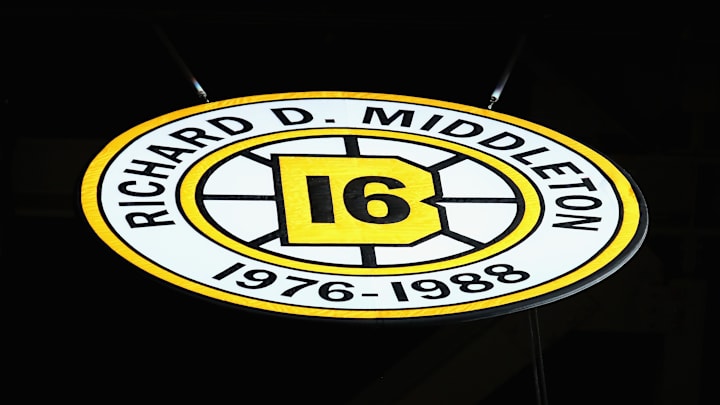The Boston Bruins were just the second franchise in professional sports history to retire a number, honoring Lionel Hitchman after his last NHL game on February 22, 1934, by retiring his number 3 jersey. Since then, the Bruins have retired a total of 12 numbers for historic forwards and defensemen, most recently number 16 for Rick Middleton in 2018, and number 22 for Willie O’Ree in 2022.
When you look at the Bruins' retired numbers, you will notice there is a glaring omission. The organization has never retired the number of any goaltender in their history. Every other Original Six franchise has retired at least one of their past goalie’s numbers. The Bruins have multiple record-holding, Hall of Fame goaltenders among their alumni, so why haven’t any of them been properly celebrated?
There are specifically two numbers that come to mind when thinking back at Bruins goalies that should be in the rafters, the numbers 1 and 30. The netminders that have made a historical impact on the franchise while wearing these numbers are Cecil ‘Tiny’ Thompson and Frank Brimsek representing the number 1, with Gerry Cheevers and Tim Thomas representing the number 30. All four of these goaltenders had a hand in winning each of the six Bruins Stanley Cups, each holds NHL and team records, and three of the four are in the Hockey Hall of Fame. There are many reasons 1 and 30 should be retired, so why aren’t they?
Number 1: Thompson & Brimsek
Tiny Thompson had his first NHL start on November 15, 1928, kicking off his career with a 1-0 shutout victory over the Pittsburgh Pirates. The result would be a good indicator of how the rest of his Bruins career would play out, as he finished his rookie season with 12 shutouts and he now holds the franchise record for most career shutouts (74). Thompson also finished his rookie campaign with a 1.15 GAA, which is still the Bruins team record for lowest GAA in a season. Boston went on to win their first-ever Stanley Cup that season, going 5-0 on their road to the Cup, with a 0.60 GAA, which is tied with Alec Connell for the NHL record of lowest GAA in a playoff year.
The next season, the Bruins set the NHL record for best winning percentage in a season (87.5%) when they went 38-5-1 with Thompson in net. The 1929-30 Bruins still hold that record. Thompson went on to win his first Vezina Trophy that season, and also set the NHL record for the longest win streak in a season (14 games), which has been tied three times since he set it (Tom Barrasso, Jonas Hiller, Sergei Bobrovsky). Over his 10 seasons with the Bruins, Thompson won the Vezina four times (1930, 1933, 1936, 1938) and was a four-time All-Star. Along with the records already listed, Thompson also recorded the first intentional goalie assist in the 1935-36 season and holds the Bruins franchise records for lowest career GAA (1.99) and lowest playoff career GAA (1.72). Thompson was inducted into the Hockey Hall of Fame in 1959.
After his Vezina-winning season in 1937-38, Thompson was injured in an exhibition game before the 1938-39 season. His injury made way for Frank Brimsek to be called up from the Bruins minor-league affiliate, the Providence Reds, to start in his place. Bruins coach and general manager, Art Ross, was so impressed that he traded Thompson to the Detroit Red Wings on November 16, 1938, making Brimsek the new starting goaltender for Boston.
After Thompson was traded, Brimsek went on to post six shutouts over seven games. Brimsek holds the Bruins record for the longest shutout sequence over this time (231 minutes, 54 seconds), which earned him the lasting nickname, ‘Mr. Zero’. Brimsek won the Vezina and Calder Trophies at the end of his rookie season, and the Bruins went on to win their second Stanley Cup. Just two years later, Brimsek backstopped the Bruins to the franchise’s third Stanley Cup victory, when they swept the Red Wings, 4-0. In 1941-42, Mr. Zero led the league in GAA (2.35) and won his second Vezina.
Following the 1942-43 season, Brimsek suspended his NHL career to join the United States Coast Guard during World War II. When he returned, he helped lead the Bruins to the 1946 Stanley Cup Final, which they lost to the Montreal Canadiens in five games.
The Bruins didn’t make it to the Cup Final again with Brimsek in net, but he ended up being the runner-up for the Hart Trophy in 1948. Brimsek was an eight-time All-Star and still holds the Bruins record for longest point streak in a season (23 games in 1940-41). He was traded to the Chicago Blackhawks on September 8, 1949, ending his 9 seasons with Boston. Brimsek was inducted into the Hockey Hall of Fame in 1966, the first American-born goalie to be inducted, and in 1973 he was an inaugural inductee into the US Hockey Hall of Fame.
